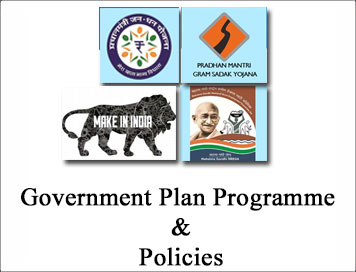(HOT) UPSC Current Affairs 2025 PDF
NEW! The Gist (NOV-2025) | E-BOOKS
Government Plan Programme Policies for UPSC Exam: Changes in Budget Making

Government Plan Programme Policies for UPSC Exam
:: Changes in Budget Making ::
Budget is a socio economic document which is gien under Art 112 of Constitution. The budget is prepared by the budget division in department of economic affairs, Ministry of Finance. Budget making itself is not a one day issue, it passes through various stages. In total Budget goes through following processes. First to come up is Formulation of Budget, then budget would be approved by the legislature, finally the execution and auditing of the Budget ammount takes place. Process of budget making itself takes more than six months. The five year plans are referred to discuss the gross budgetary support from the union government to support the annual plans. The real test of the budget maker is to pass the legislation which fiscally disciplines the government. The fiscal responsibility and Budget management (FRBM) act sets the target of keeping the revenue deficit nil and fiscal deficit below 3%. The process of budget takes final shape in around month of January when the revenue. By convention the union budget is presented on the last day of February in the Lok Sabha. The budget is tabled at the Rajya Sabha only after the finance minister completes its speech in the Lok Sabha. A broad discussion takes place at this stage without any voting. Then the house is adjourned.
The Union Cabinet has approved the proposals of Ministry of
Finance on certain landmark budgetary reforms relating to (i) the merger of
Railway budget with the General budget, (ii) the advancement of the date of
Budget presentation from the last day of February and (iii) the merger of the
Plan and the Non-Plan classification in the Budget and Accounts. All these
changes will be put into effect simultaneously from the Budget 2017-18.
The arrangements for merger of Railway budget with the General budget have been
approved by the Cabinet with the following administrative and financial
arrangements-
1. The Railways will continue to maintain its distinct entity -as a
departmentally run commercial undertaking as at present;
2. Railways will retain their functional autonomy and delegation of financial
powers etc. as per the existing guidelines;
3. The existing financial arrangements will continue wherein Railways will meet
all their revenue expenditure, including ordinary working expenses, pay and
allowances and pensions etc. from their revenue receipts;
4. The Capital at charge of the Railways estimated at Rs.2.27 lakh crore on
which annual dividend is paid by the Railways will be wiped off.
5. Consequently, there will be no dividend liability for Railways from 2017-18
and Ministry of Railways will get Gross Budgetary support.
6. This will also save Railways from the liability of payment of approximately
Rs.9,700 crore annual dividend to the Government of India;
The presentation of separate Railway budget started in the year 1924, and has continued after independence as a convention rather than under Constitutional provisions.
The merger would help in the following ways:
- The presentation of a unified budget will bring the affairs of the Railways to centre stage and present a holistic picture of the financial position of the Government.
- The merger is also expected to reduce the procedural requirements and instead bring into focus, the aspects of delivery and good governance.
- Consequent to the merger, the appropriations for Railways will form part of the main Appropriation Bill.
Advancement of the Budget presentation:
The Cabinet has also approved, in principle, another reform relating to budgetary process, for advancement of the date of Budget presentation from the last day of February to a suitable date. The exact date of presentation of Budget for 2017-18 would be decided keeping in view the date of assembly elections to be held in States.
This would help in following ways:
-
The advancement of budget presentation by a month and completion of Budget related legislative business before 31st March would pave the way for early completion of Budget cycle and enable Ministries and Departments to ensure better planning and execution of schemes from the beginning of the financial year and utilization of the full working seasons including the first quarter.
- This will also preclude the need for seeking appropriation through 'Vote on Account' and enable implementation of the legislative changes in tax; laws for new taxation measures from the beginning of the financial year.
Merger of Plan and Non Plan classification in Budget and Accounts:
The third proposal approved by the Cabinet relates to the merger of Plan and Non Plan classification in Budget and Accounts from 2017-18, with continuance of earmarking of funds for Scheduled Castes Sub-Plan/Tribal Sub-Plan. Similarly, the allocations for North Eastern States will also continue.
This would help in resolving the following issues:
-
The Plan/Non-Plan bifurcation of expenditure has led to a fragmented view of resource allocation to various schemes, making it difficult not only to ascertain cost of delivering a service but also to link outlays to outcomes.
-
The bias in favour of Plan expenditure by Centre as well as the State Governments has led to a neglect of essential expenditures on maintenance of assets and other establishment related expenditures for providing essential social services.
-
The merger of plan and non-plan in the budget is expected to provide appropriate budgetary framework having focus on the revenue, and capital expenditure.

